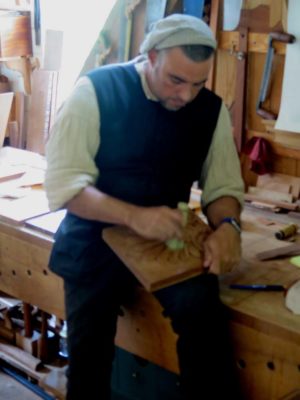 As many of you already know, I write out of order. It is, perhaps, the most irritating part of my own writing process—at least to me. Fortunately, this new world of publishing really works for someone like me. Everything I write is not set in stone. I can move the pieces around when I’m done.
As many of you already know, I write out of order. It is, perhaps, the most irritating part of my own writing process—at least to me. Fortunately, this new world of publishing really works for someone like me. Everything I write is not set in stone. I can move the pieces around when I’m done.
Why am I starting like this? The clue is in the subtitle. This really isn’t Part 5 of the Discoverability series, even though it should be. When I put this into a little book—and I’ll do that when I’m finished—this will be part one.
You see the marks on my forehead? That’s the visible sign of head-desk syndrome.
Because what I’m writing about this week is something I already knew—I’ve said it over and over in the contract pieces—but I never ever put it together with all of writing, and I never thought of the implications before. Especially what those implications mean to discoverability.
We all know that our industry—publishing—is going through a massive disruption caused by new technology. The disruption is in two areas—the production system and the distribution system.
It’s easy and cheap to produce a book these days. Understand that I’m not talking about writing one. I’m talking about the things that happen after the book is finished. Please be clear on that, because if you misunderstand that point, you’ll miss the point of the entire blog.
In the past, it took tens of thousands of dollars to produce an actual physical book. Then you’d end up with a warehouse (or a garage) full of books, and no way to get them to a customer.
In the early part of the 20th century, a lot of writers self-published and ponied up that large amount of money. But by the middle of the century, writers couldn’t get the books to market, even if the writers produced the books.
Traditional publishers created a lock on the distribution system that was pretty extreme. Books went from the publisher’s warehouse to hundreds of distributors all over the country, who sent the books to bookstores, grocery stores, truck stops, and drugstores. Any place that wanted books could get them.
That system was already breaking down when Amazon started up in the mid-1990s. The main part of the distribution system had collapsed by the end of the century, murdered by large stores that wanted centralized ordering. The day of the local distributor who knew what his customers wanted disappeared.
Books got delivered to bookstores and a few non-bookstore chains, like grocery stores. But the small non-bookstores that used to get a spinner rack of books? Those stores couldn’t order books if they tried. The markets contracted.
Traditional publishers responded to this contraction by getting rid of the bulk of their sales reps, leaving a small sales force that mostly sold to a handful of buyers. Traditional publishers changed editorial strategy to meet the new reality, trying to find books that would appeal to a mass audience, just as the mass audience in all other parts of entertainment was breaking into pieces.
If traditional publishers want to know why Amazon was successful, it was because Amazon distributed books to the people who wanted them. Amazon didn’t try to dictate who should get what book. (Nor did it chastise its customers for shopping elsewhere, something a lot of independent bookstores still do.) The shopping experience on Amazon wasn’t pleasant at first; it isn’t always pleasant now. But it is useful, and easy.
Thanks to Amazon and other online retailers, books went from the publisher to the online site to the customer. Note that this procedure cut out at least one middleman.
Combine all of that with the ease of production, and suddenly, midlist writers and wannabe writers didn’t have to go to traditional publishers to get books to readers. Even without the rise of e-books, even if the only change in the system had been the low-cost self-published paper book, writers still would be going direct in much larger numbers than ever before.
The one thing traditional publishers did not change in response to this two-pronged attack on the old system was the marketing strategy. Marketing really is all about discoverability, getting the customer to find something that is new to them, not necessarily newly produced.
As the outlets for books shrank, traditional publishers did nothing to compensate. Nothing.
Here’s what a physical book rack is. It’s advertising. Even if a shopper does not buy a book off that rack, she sees the books, notes them, and maybe decides to buy them from her favorite store or get the book from the library. People discover books by browsing. I don’t care how good Amazon’s analytics are, they simply do not compare to that moment of discovery—that moment when a weird-looking book catches your eye, you pick it up, and realize that it’s heavier than expected and the deckle edge makes the book prettier than you originally thought.
Holding a book is a sensual experience, one that book lovers adore. You might decide to buy the e-book instead, but you might never have seen that book if you hadn’t been standing in that store at the moment the book was on the shelf, and you happened to see an intriguing cover (or title or something).
Traditional publishers panicked about the changes in distribution, but did nothing to combat it. They didn’t increase their sales force, and try to take the books themselves to independent bookstores. They didn’t woo regional grocery chains (as opposed to national ones). They didn’t talk to museums or truck stops or department stores, any other place that used to take books.
Traditional publishers gave up without a fight.
Worse, they maintained their marketing strategy, as if the old 20th century system was still in place.
Go back and read my two posts on the old ways. Please understand that those old ways were built for a completely different world. And they were built for a different type of business.
The different type of business is where the paradigm shift comes in. Let’s go back to the very basics, here, which I have said a million times in my contract posts. Writers do not sell books.
Repeat after me: Writers do not sell books.
Writers license copyright.
I always follow that statement with this one: if you don’t understand what I mean, then buy the Copyright Handbook and read it. I tell writers that all the time, and I can always tell by their questions and their actions whether or not they have read and understood the book. Too many simply have not a clue what copyright even is.
Let me tell you.
Copyright is property.
And an even nicer thing about copyright is that it’s intellectual property. Unlike a physical object which can be sold and you’ll never see it again, intellectual property exists in many forms. My husband, Dean Wesley Smith, believes those forms may be infinite. He limits them to a writer’s imagination. He likens it to a bakery—a magic bakery—which sells only pies.
I’ll let Dean explain:
Think of us (every writer) as a huge bakery and all we make are pies. Magic pies, that seem to just reform after we sell off (license) pieces of the pie to customers.
And each pie can be divided into thousands of pieces if we want.
The Magic Pie secret ingredient is called “Copyright.”
Every story we write, every novel we write, is a magic pie full of copyright.
We can sell (license) parts of it to one publisher, other parts to another publisher, some parts to overseas markets, other parts to audio, or eBooks, or game companies, or Hollywood, or web publishers, and on and on and on. One professional writer I knew licensed over 100 different gaming rights to different places on one novel. He had a very sharp knife cutting that small section of his magic pie.
You really need to read the article in which he discusses the magic bakery. It has a different focus than I have here. But I’m going to add just one more thing from Dean’s post:
You create the inventory, the pie, just once, but can license it for your entire life, having pieces you licensed keep coming back to the pie over and over, and your estate can keep taking and licensing parts of that pie for seventy years past your death. Nifty, huh?
Are you all starting to see why Kris and I are harping all the time about bad traditional publishing contracts? If you give too many rights to work away for too long, it never returns to your bakery to make you money. (Maybe in 35 years…again, study copyright.)
Magic pies are a great thing. They’d be even better if they had magic calories that stuck to you if you needed them, and dropped off if you didn’t. But that would be another story.
Here’s a different way to think about your book, copyright, and intellectual property. Think of it as property.
Let me be more specific. Think of it as a house that you built. You already have a home, so you’re not building the house for personal shelter.
You put time and effort into that newly built house, not counting the costs of construction (which, in the case of writing, would be the care and feeding of the writer, the overhead [which is the computer time and the electricity], and on and on). So you have an investment in that house right from the very beginning.
When the house is finished, you could sell it. You would probably make quite a bit of money up front if, of course, you built the house right and you had the ingredients that people wanted, in a neighborhood they wanted. If you were good at house-building, you’d recoup your investment in that house, plus a percentage.
That percentage is your profit. It might be a few thousand. It might be tens of thousands. It might be hundreds of thousands. But that’s all you will ever get from the house, because the house is no longer yours.
Pretty simple, huh?
Now, if you rent the house, you won’t recoup your investment right away. It’ll take time to make the initial investment back and even longer to make a profit. Once you pass that profit threshold however, the earning continues. Yes, you might have to do some maintenance here and there, and you’ll have to pay attention to the overall marketplace, particularly when it looks like the current tenant is about to leave. But the house will continue to earn for you as long as you own it and as long as you keep it on the rental market.
The analogy breaks down a bit here, because copyright is not like a house, at some point, the copyright on that property will fall into the public domain (unless you’re really smart and know how to manipulate copyright legally to maintain copyright on some bits of the property—and no, I’m not going into that here). But stick with real estate for a moment.
You guys are familiar with the property argument for contract purposes because you’ve been reading my blog. But we’re talking about discoverability here, not contracts.
What’s the difference?
Marketing.
When you put that house up for sale, you have one chance to recoup your investment. Just one. So you get the word out everywhere. You want velocity. You want that house to sell as fast as possible, so you can make your money back as fast as possible.
Then, if you rehab or build a lot of houses, you’ll pour that money into another project and do it all over again. Build, sell, profit. Build, sell, profit.
By the end of the year (if this isn’t a year like 2008-2010), you’ll make a tidy sum of money. Not enough to retire on, but enough to get you through the next year and the next.
The problem is you’re working your butt off. You’re working on the sell/velocity model. The faster you build, the faster you sell. The faster you sell, the faster you make a profit.
All of your marketing efforts focus on that first moment when your property goes up for sale.
But…
What happens if, two years after you sold that property, the neighborhood it is in gets gentrified? That neighborhood becomes the cool neighborhood, the one everyone who is anyone wants to live in, and they’ll pay ridiculous prices to buy a house there.
Will you get a piece of that ridiculous price?
Hell, no. You sold the house two years ago. All of it. Every last bit of it. You’ll never see another dime from that house. You’re done.
What if you kept the house and rent it? Well, let me tell you as a former rental agent, that when a neighborhood becomes gentrified, the rents go up along with the housing prices. The cool people who can’t buy (or can’t afford to buy) will rent, and at inflated prices.
If you still own the house and rent it out, you’ll be making more money per month than you made when the house was finished years before.
You might invest some money into marketing when the neighborhood becomes hot. One of the property owners I used to work for advertised his upscale rentals even when they weren’t available. He was creating buzz, he was making them desirable, and when those rentals became available, they stayed available for hours, not days, not weeks, not months.
The man was a savvy marketer. He always advertised his upscale housing. But he never advertised his student housing. Ever. He didn’t need to. That’s what I managed. The student properties. And they rented in about two weeks in March—for the beginning of the Fall Semester. By the end of the first week in March, all the good student housing was gone. Only the mediocre-to-crappy stuff remained. And that was gone by the second week of March.
So how did new students get rental housing? They didn’t. They had to live in university housing—dorms or graduate apartments. New students didn’t find out about off-campus housing until they’d lived in town for a while.
Discoverability.
Because there was a built-in (continually refreshing) market for student housing, and because there wasn’t enough off-campus housing for everyone who wanted it, the student housing needed no boost from advertising dollars. In fact, that ad money would have been poorly spent.
But, the upscale housing needed the constant boost, because—to be honest with you—the neighborhood wasn’t yet the best in the city. It aspired to be the best, but hadn’t achieved it yet. Without the word-of-mouth, and the occasional buzz, those properties would not have remained full.
Was my old boss able to rent all of his former properties? Hell, no. He had rentals that needed work and rentals in undesirable neighborhoods, that turned over every few months, instead every year. The complexes had a lot of vacancies. He also had new properties that had just been completed that no one had heard of yet, and were less than 20% full.
Was he panicked? Nope. That vacancy rate was built into the earnings projections. His marketing campaigns hadn’t even started for the new properties, and it wasn’t worth marketing the old ones until they got spruced up.
I do want you to note something: The new properties didn’t fill immediately, and my old boss didn’t panic. Because he wasn’t working on the velocity model. He wasn’t trying to sell something to recoup his money fast. He was handling earnings over time.
He was treating the properties as investments.
“Investments” as defined in the financial field (not in economics) are all about putting money into an asset with the hope of good return (in the form of appreciation, dividends, interest earnings, etc.). All investments involve risk. The key to investing is to manage the risk in relation to the reward.
Before you make an investment, you need to calculate what sort of return you want from it.
Again, let’s go back to our house. If you need a quick return, you might sell the property. However, you might want to hold onto the property and make a small annual return in the hopes that the property will appreciate.
Before you do anything with the property, you decide what you want from it.
Now, let’s return to writing. Most writers want to be published. Then they get published and they realize they want their books to make money. Most writers hope to make millions, usually within the first year. Hardly anyone ever does that. Over time, perhaps, but never up front.
Writers rarely (read: almost never) think about their time as an investment, and the writing they produce as an asset. These are tough concepts, because publishing changed twice in my lifetime, and the old thinking got engrained.
From about 1920 to about 1960, traditional publishers were smaller companies, generally owned by their founders. I’m currently (yes, still) reading Hothouse, the history of Farrar Straus Giroux, and FSG’s main owner from its founding in the 1930s to the early 1990s was Roger Straus.
Straus tried to buy as many rights as possible from his writers, particularly in the early days, so that he could then apply the magic-bakery thinking to these assets he purchased from the know-nothing writers. Straus kept the properties he bought in print, and he capitalized on waves that came through. That’s why FSG made money when Isaac Bashevis Singer won the Nobel Prize in 1978. The company did not have to find Singer’s backlist and reprint it. They had had it in print for years. They did have to do additional printings, but that’s different, and less costly.
In other words, back in the old days, traditional publishers treated books as assets, not just in accounting, but in practice as well. If there was a bandwagon to jump on six years after a book was published, the traditional publisher had the in-house memory to know the book belonged on that bandwagon. Since the book was in print, the publisher could jump fairly nimbly onto that bandwagon with just a change of marketing.
The first wave of corporate mergers in publishing started around 1960, and got worse in the ensuing forty years. Traditional publishing kept books as assets in accounting, but no longer treated them like assets in practice. Instead, traditional publishing treated books like widgets and counted those widgets as inventory. Stock. Stuff that would grow stale and have no value—which was why writers could win awards a year after the book came out, and no reader could find the book, because the publisher had determined that the award-winning widget was already past its sell-by date, and didn’t need to be reprinted.
Instead of making money off the bandwagon, traditional publishing let most parades march on by.
This thinking became so pervasive—forty-plus years of pervasive—that when Dean and I taught beginning writers, we told them that when they took their books to market, they had to think of the books as widgets.
We also told the writers to negotiate their contracts and keep as many rights as possible, treating the books as assets that needed to be protected.
Yes, we were as crazy as the rest of publishing, and only recently have I realized just how deep the crazy went.
This series has helped with that.
Because if you are marketing a widget that will spoil within a few months, then your marketing plan is based on getting the most out of that widget in the shortest amount of time. Not only that, but you’ll need a different widget in the second month, and yet another widget in month three.
But, if you are accumulating assets, then you need to manage the asset. You might not choose to market the asset at all until you figure out exactly what you want from the asset.
The fascinating thing about assets, folks, is that their value isn’t constant. The values are in flux. Sometimes an asset isn’t worth what you paid for it, and sometimes the asset’s value is outrageously inflated.
Mostly, though, people who manage assets manage a lot of them. How many investors do you know who only own one share of stock? I know no one who manages rental properties for a living who only has one property. I know a lot of people with day jobs who also own one rental. Just like I know a lot of writers with one novel who also have day jobs.
So…
The paradigm shift is pretty simple to say and difficult to comprehend.
Every item that you write is an asset. More than that, each asset can be divided à la the magic bakery into dozens, maybe hundreds, more assets. Then you need to decide how you want to market each asset.
Each asset needs its own investment calculation done so that you can figure out what to expect from that asset and how best to handle the asset.
Not every asset needs a marketing plan—at least not in 2014. Not every asset needs careful tending. Most assets don’t do well in the velocity method, although a handful do.
Because our assets exist in the entertainment field, we want customers to interact with the asset—whatever that means (play a game from it, see a movie based on it, read the short story that started it all). We want those customers to find each asset. We also want to make a small profit off of each asset, so that we can live off our investments.
When you start thinking of your writing as an asset which will, if you do things right, appreciate in value over time, then you realize that applying marketing methods based on widgets that will spoil does your asset no good at all.
Your thinking has to change before we start talking about ways to market your asset. Or not market your asset. Or market some of your assets and leave the rest alone.
Think of my former boss, the man who marketed the assets that needed constant championing, maintained the assets that were doing well without an marketing at all, and didn’t market the assets that still sprucing up. Each time he advertised something, he had a reason for doing so. That reason had to do with managing assets, not with becoming famous or making a financial killing using suspect methods because “that’s how it’s always been done.”
As you move into 2014, practice thinking of your output—all of your output—as individual assets. If the magic bakery doesn’t work for you Star Trek fans, then think of your work as tribbles hiding in a pile of grain. Each story can have a thousand lives, if you let it. Each life is an asset. And each asset might require marketing so that it can be discovered. Or it might simply need to be left alone to grow on its own.
It’s a difficult shift to make, growing up as we all did in Widget World. But it’s a shift we need to make.
It’s time.
Fortunately, I’ve been able to carry two contradictory thoughts in my brain at the same time. I’ve always treated my copyrights as assets, but I used to market (and write) my fiction as if the stories were all widgets. I know now that I operate in a writing world without widgets.
Unfortunately, the one constant remains the amount of time it takes me to write new material. And these blogs take time away from my fiction writing, which is the most lucrative part of my investment portfolio.
That’s why I put a donation button on my nonfiction, but not on my fiction. I need a little added incentive to keep writing the blog, an incentive I don’t need for the fiction.
Thank you all for coming here every Thursday, and thanks for the support you give me by linking to others, discussing ideas in the comments, e-mailing me, and yes, donating. I appreciate all of it more than I can say.
Click Here to Go To PayPal.
“The Business Rusch: A Paradigm Shift (Discoverability Kinda)” copyright © 2013 by Kristine Kathryn Rusch.
SPECIAL NOTICE: I’d like to put out a call to those of you who are traditionally published. I need to update my Deal Breakers book for 2014. I have quite a bit of material, but I would like to see what I’ve missed.
So if you received a traditional publishing contract from a major publishing house and/or an agency agreement from an agent, please black out all the personal information and send it to me. I’m particularly interested in the contract clauses you negotiated away and/or that you walked away from.
I also would like to see the clauses you’re proud of getting. The ones where you feel you triumphed in your negotiation.
I need the entire contract, because a contract is a living document, and what it says on page 13 has an impact on what it says on page 2. Please black out your name, the name of your agent, the advances, etc., and send me the file.
I promise, I will not use your name or any personal information, except that I might say something like “a first-time author” or “an author who has published novels for fifteen years” or “a bestselling author.” I won’t even use a personal pronoun to give your secret away. And I’ll be the only one who looks at this.
If you want to see how I do this, look at the Addendums post from earlier this year. (And yes, that will be in Deal Breakers 2014.)
Thank you! I appreciate all of the help.


Send to Kindle




























































 Send to Kindle
Send to Kindle


 David Kudler is a writer and editor living just north of the Golden Gate Bridge with his wife and daughters. And cat. And many guppies. He serves as publisher for
David Kudler is a writer and editor living just north of the Golden Gate Bridge with his wife and daughters. And cat. And many guppies. He serves as publisher for 


